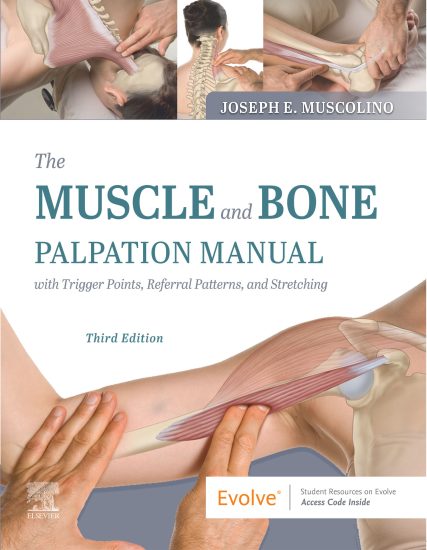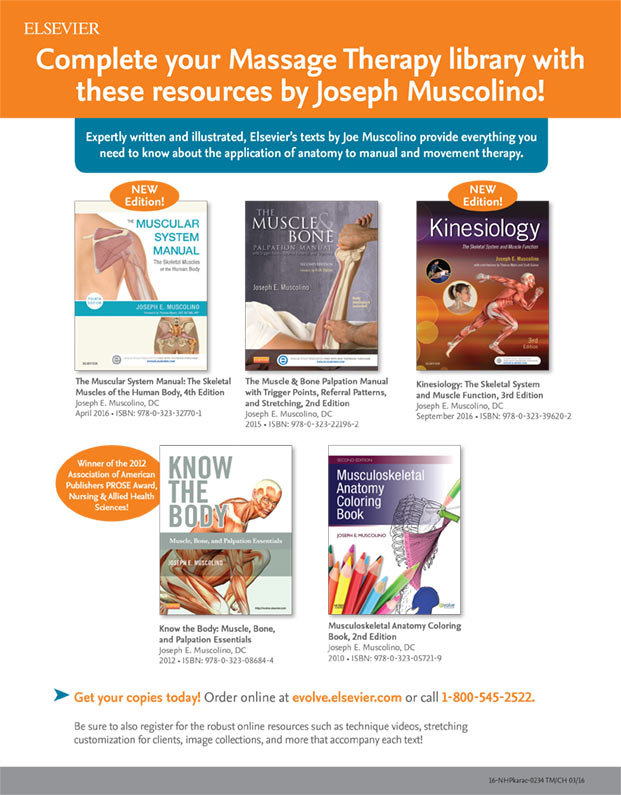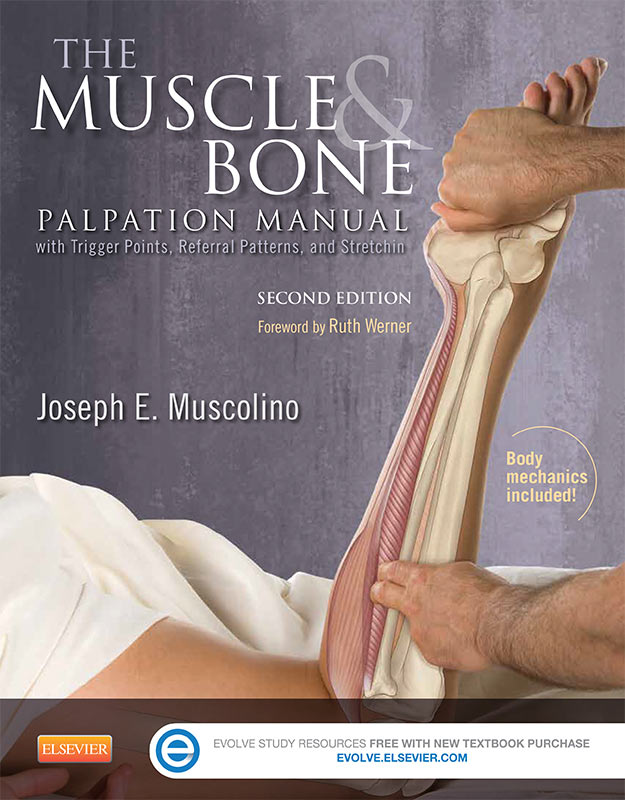 Organization
Organization
The Muscle and Bone Palpation Manual is organized into four parts and contains a set of 2 DVDs.
Part 1 covers assessment. Three chapters are provided that explain the art and science of how to palpate, as well as a chapter on orthopedic assessment. These chapters simply and clearly explain the guidelines that will help you become an effective and confident palpator. All of the major orthopedic assessment tests are also shown and explained.
Part 2 covers treatment techniques and includes four chapters. The first chapter covers the logistics of treatment by providing an atlas of massage strokes and draping methods for massage. The second chapter explains what trigger points are and how they are formed, along with what is likely a treatment method superior to ischemic/sustained compression. The third chapter explains how to reason out stretches for the muscles of the body, and explains how to perform advanced stretching techniques, such as contract relax (CR) stretching (also known as proprioceptive neuromuscular facilitation [PNF] stretching), and agonist contract (AC) stretching. And given the crucial importance of body mechanics to the student and therapist, there is also a chapter that offers 10 guidelines that will appreciably improve the efficiency with which you work.
Part 3 is composed of three chapters that cover palpation of the bones, bony landmarks, and joints of the body, as well as covering the ligaments of the body. Effective palpation of the bones and bony landmarks of the body is a crucial first step before muscle palpation can be tackled. Effective palpation of the joints is also a necessary skill for assessment of client/patients. Each chapter in Part II also contains a thorough set of anterior, posterior, and lateral illustrations, depicting the ligaments of the body.
Part 4 is the masterpiece of the book. It contains 11 chapters that cover palpation of the skeletal muscles of the body. Each chapter presents a tour of the muscles of a region of the body. For each muscle, a step by step palpation is presented, with the reasoning given for the steps so that the palpation can be understood and easily remembered, instead of being memorized. The illustrations are superbly done with the bones and muscles drawn over photographs of real people, offering the most accurate and clear renderings of the muscles and muscle palpations possible. In addition, a unique muscle stretch illustration is given for each and every muscle covered, as well as trigger point and trigger point referral zone information and illustrations for all the muscles.
Ancillaries for the Instructor
In addition to the clear and simple, yet thorough, approach to the content of this book, the entire book is available in 50-minute Power Point presentations complimentary for any school that adopts this book into their curriculum. The Power Point presentations are accompanied by complete lesson plans along with learning objectives, critical reasoning questions, classroom activities, and more. An image bank containing every illustration in the book, as well as a 1,000 question test bank, are also available complimentary to schools that adopt this book.
 Electronic Resources
Electronic Resources
To enhance muscle palpation illustrations and text in Part III of this book, a set of 2 DVDs (included free in the book) contains over 4 hours of video demonstrating the muscle palpations of the book. This DVD set also contains cameo presentations by some of the most prestigious names in the world of massage therapy education, including Tom Myers, Leon Chaitow, Whitney Lowe, Bob King, Gil Hedley, and many more. Additional free online resources are included on the companion Evolve website, including technique videos for the intrinsic muscles of the hands and feet, interactive review exercises, a massage research PowerPoint presentation, and joint motion information.
Other Resources
Also available for the student and practitioner is a companion set of full color flashcards covering all of the muscle and bone palpations, as well as the majority of muscle trigger point and referral zone illustrations. These flashcards provide an excellent study aid for the student and therapist alike to help learn the palpation protocols and trigger points. A full color practitioner flip chart containing the trigger point and referral zone illustrations and stretching illustrations is also available. This flip chart is an invaluable addition to every practice, offering a quick review at a glance of the trigger points and their referral zones as well as the stretches for your clients/patients. It also serves as an excellent client/patient education tool when explaining to clients how tight spots in their muscles can refer pain to other parts of the body, as well as visually showing your clients/patients stretches that you recommend for them.
Final Note
No other book offers as much to you as The Muscle and Bone Palpation Manual. It contains the most thorough and clear palpation methods accompanied by the highest quality illustrations possible, and it includes a 2-DVD set demonstrating the palpations, too! Further, it offers a complete set of stretches and trigger point illustrations for the skeletal muscles of the body. With chapters on how to palpate, how to stretch, and understanding trigger points, a complete coverage of the ligaments, a compendium of all major massage strokes and draping methods, and a thorough chapter on body mechanics, The Muscle and Bone Palpation Manual will easily take the place of three or four books needed in your library.
Here are video clips from DVD1 of The Muscle and Bone Palpation Manual with Trigger Points, Referral Patterns and Stretching:
1. How to Palpate 2. Subscapularis 3. Adductor magnus 4. Longus colli 5. Piriformis
CLICK HERE TO ORDER THE PAPER BOOK CLICK HERE TO ORDER THE E-BOOK

For Elsevier international orders, use the links below:
Asia http://www.store.elsevierhealth.com/asia/
Australia/Fiji/New Zealand http://www.elsevierhealth.com.au/
Brazil http://www.elsevier.com.br/site/Default.aspx
Canada http://www.elsevier.ca/index.jsp
France http://www.elsevier-masson.fr/
Germany/Austria/Switzerland http://www.elsevier.de/
Japan http://www.store.elsevierhealth.com/japan/
Korea http://www.store.elsevierhealth.com/korea/
Mexico http://www.elseviermexico.com/home2.html
Poland http://www.elsevier.pl/
Spain http://www.elsevier.es/es
UK http://www.elsevierhealth.co.uk/

